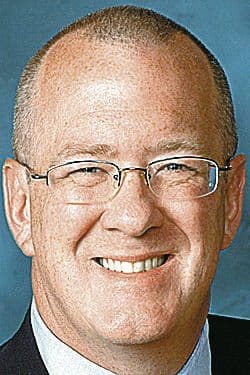The economic recovery that began in the summer of 2009 is now over for Indiana.
Factory employment is down for the year, and overall employment is on trend to be down in 2019. Overall employment has only declined in Indiana a dozen times since the end of World War II, marking precisely the dozen post-war recessions. The nation might not slip into recession, but by any meaningful measurement, Indiana now has.
Sadly, the recovery has been very poor, partly because our education policies have dampened the type of workforce vibrancy that is the hallmark of a healthy economy. Worse still, this sets us up for tough decades ahead.
Since the third quarter of 2007, when the economy was booming, Indiana’s workforce down-skilled profoundly. We’ve seen 31 percent growth in workers with less than a high school diploma, nearly no change among those with high school diplomas and under 5% growth among those who have been to college or have an associate’s degree. The simple fact is from third quarter 2007 to third quarter 2018, a whopping 55 percent of new workers had less than a high school diploma.
I believe much of this is attributable to education policies that focus on supplying our economy with workers instead of citizens. While this might have pleased a few important political donors, it remains deeply misguided. I call it the Mississippi strategy, because it pushes Indiana into the bottom tier of educational attainment. And from the looks of it, it is doing just that.
I have three broad critiques of this effort. It begins by simply noting that young men and women are not widgets who can or should be pushed into careers that benefit the local economy. This approach, adopted by the state’s educational policymakers, is deeply misguided, empirically unsupportable and acutely authoritarian.
The goal of education isn’t to provide a workforce, but citizens. Of course citizens work, but they should not be pushed into fields deemed worthy by a committee convening in Indianapolis. The results are embarrassing. Take just one example. In an effort to cut college costs and have more students finish early, the General Assembly cut spending on higher education. As a share of GDP, spending dropped from 0.74 to 0.62 percent. That is more than $2,300 less per Hoosier college student each year.
In response, the state’s three largest universities have slashed the number of in-state students they enroll as undergraduates. Purdue’s in-state enrollment since 2010 dropped from 62.9 percent to 52.2 percent (using 2018 data). IU’s share of in-state students dropped from 55.2 to 51.2 percent, and Ball State from 88.4 to 85.6 percent (using 2019 data). All three universities cut in-state students by a combined total of 5,663 students. They then boosted out-of-state enrollment by 6,487 at a time when Indiana high schools graduated more and better-educated high school students.
For those of you puzzled over the brain-drain problem in Indiana, look no further. Our top public universities turned away about 15 percent more qualified Hoosier students last year, enrolling out-of-state undergraduates in their place. Of course, out-of-state students pay higher tuition, but they are far less likely to remain in Indiana. It should surprise no one that states that experience net in-migration of college-aged people are the ones who more heavily subsidize education.
Our current policies are empirically unsupportable for the simple reason that the Indiana Department of Workforce Development cannot effectively predict what jobs will be needed in our state next year, much less over the expected work life of a teenager today. For example, the current policy is based on a prediction that more than a million jobs would be needed between 2014 and 2024, of which most required a high school diploma. That forecast would’ve required more than half of all Indiana workers with a high school diploma in 2014 to retire by 2024 and be replaced by almost half our high school graduates. Nonsense.
Those who’ve designed our workforce policies might benefit from being reminded of Freidrich Hayek’s great 1988 book "The Fatal Conceit," in which he noted "the curious task of economics is to demonstrate to men how little they really know about what they imagine they can design."
And finally, the strategy is acutely authoritarian. As I’ve written before, there are sixth graders in Indiana now enrolled in career paths to be truck drivers. While truck driving is a good and noble profession, the notion that sixth-graders should be focusing so narrowly enjoys precisely zero research support. It exists solely through the lobby efforts of one industry who is afraid of paying higher wages. This is immoral in so many ways that I could provide a dissertation-length critique of its absurdity.
Instead, I will simply ask if anyone supposes there is a single CEO of any of Indiana’s many great logistics firms whose 12-year-old child is pursuing the truck driver career path.
Many readers will mistakenly suppose I am against career and technical education. Nothing could be further from the truth. I personally embrace a culture that holds that all labor is imbued with inherent worth. But our education policies are now doing almost precisely the opposite of what is now happening.
We should be educating for citizenship, not employment. We should be educating to end the brain drain, rather than magnify it. We should be educating every child to pursue the fullest opportunity they can possibly have today, and into the distant future. Right now, we are doing precisely the opposite of all of these.
Our human capital policies have weakened Indiana and are failing us today with respect to brain drain and wage growth. The Mississippi strategy is a profound mistake, which will bear bitter fruit for years — if not decades — to come.
Michael J. Hicks is the director of the Center for Business and Economic Research and the George and Frances Ball distinguished professor of economics in the Miller College of Business at Ball State University. His column appears in Indiana newspapers.





